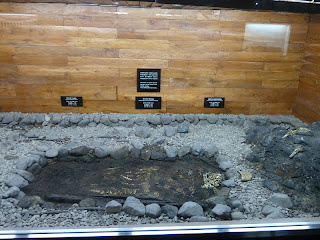Expecting a typhoon the next day, we tried to see as many sights in Gyeongju as possible. We left the Shilla Milleneum Park to go see the royal burial mounds, which is probably the main tourist site in the area. There are over 200 tombs in the surrounding valley and the Tumuli Park site contains about thirty of these mounds. These large tombs have a wood-lined chamber covered in a mound of boulders and earth. We were able to go inside "Cheonmachong", which is known as the Heavenly Horse Tomb, and is the largest mound measuring 23 meters high and 120 meters long by 80 meters wide. A total of 11,500 artifacts were excavated from the tomb in 1973-75 and many are on display in museums throughout Korea.
Bulguksa Temple was built in 528 during the Silla Dynasty, in the 15th year of
King Beop-Heung's reign (514-540). On site are two of
the most valued pagodas in Korea. Supposedly, only those who have reached enlightenment can climb the stairs from the "earth" level to the sacred Buddha level. (Yes, we made it!) Although many of the structures are similar to those seen other places, the temple site is one of the most beautiful we have visited and is the most highly treasured temple in Korea. As a side note, Koreans love to stack stones (which kind of look like small pagodas) around their Buddhist temples. I think it is a form of worship and asking for
good fortune. Emma found these formations interesting and pulled out her camera to take some photos!
By the time we left the temple, we were all ready for a filling international buffet at the hotel and a little relaxation before the rigours of sightseeing one more day.
Tuesday, Korea was hit with a typhoon which, thankfully, just brought some rain and wind. We headed over to the Gyeongju National Museum. We visited the archaeology hall which focused on relics from the Silla kingdom. (Ever wonder where those big Texas belt buckets may have originated?) From there we took Emma to the children's museum where she was able to make some treasures of her own. And finally, we walked through the Anapji Hall displaying items excavated from a pond built on the palace grounds.
With uncertainty about the strength of the typhoon we decided to call it quits and head back to Seoul. With a little coaxing, we took in one last sight - the burial tomb of General Kim Yu-sin, who was famous for making possible the unification of the Three Kingdoms of Korea. I love the look of the stone fence around his mound, which is carved with zodiac animal figures. (Unfortunately, my camera's battery died and I was unable to take more photos. I guess it was really time to go home!)






























No comments:
Post a Comment